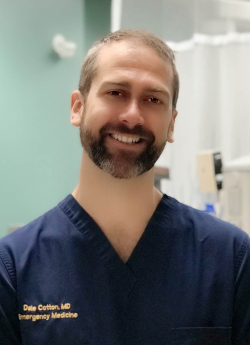Kaiser Permanente's report in NEJM AI details insights from a large-scale rollout of ambient AI clinical documentation technology.

Clinical tool accurately predicts children’s appendicitis risk in emergency rooms
A risk calculator may help safely avoid unnecessary CT scans in children 5 and older
By Janet Byron
Senior Communications Consultant
Using a new risk calculator, emergency physicians at The Permanente Medical Group (TPMG) were able to accurately gauge the risk of appendicitis in children, according to a study recently published in Annals of Emergency Medicine.
In the study, “Validation of the pediatric Appendicitis Risk Calculator (pARC) in a Community Emergency Department Setting,” the tool was validated in 11 Kaiser Permanente Northern California Emergency Departments between October 2016 and April 2018.

“Using the doctor’s exam, the patient’s medical history, and a single blood test, the pARC successfully predicted appendicitis risk from very low to high, and it did so better than previously studied tools,” says lead author Dale Cotton, MD, senior emergency physician at Kaiser Permanente’s South Sacramento Medical Center.
A difficult diagnosis
Appendicitis can be difficult for emergency physicians to diagnose in children, because children may not be able to communicate their symptoms effectively. Erring on the side of caution, emergency physicians tend to order CT scans to evaluate appendicitis in children, “but research shows that we weren’t necessarily catching more appendicitis,” Dr. Cotton says. “CT scans are costly and expose children to ionizing radiation that can increase the risk of cancer. At the same time, emergency physicians do not want to miss an important diagnosis like appendicitis.”
The pARC tool was developed by Elyse O. Kharbanda, MD, and colleagues at the HealthPartners Institute, and Anupam Kharbanda, MD, at Children’s Minnesota, with the participation of researchers from Kaiser Permanente Northern California’s Clinical Research on Emergency Services and Treatments (CREST) Network.
Using data from pediatric patients, the researchers developed an algorithm for predicting the risk of appendicitis based on sex, age, absolute neutrophil count, the duration of pain, migration of pain to the right lower abdomen, “guarding” of that area, and the most tender location during the physical exam.
Validating the risk calculator
The pARC tool accurately predicted acute appendicitis risk in 2,089 patients between 5 and 20 years old enrolled in the trial. Investigators compared the pARC with the previously best-performing tool, and found that it performed better. The pARC classified 54% of patients as low or very low risk (less than 15% risk of appendicitis), 43% as intermediate risk (between 15% and 84% risk of appendicitis), and 4% as high risk (an 85% or greater chance of having appendicitis).
“For the pARC to be a useful tool in general practice, it had to perform well in the Emergency Departments of community hospitals that care for patients of all ages,” says co-author David R. Vinson, MD, senior emergency physician at Kaiser Permanente Sacramento Medical Center and adjunct researcher with the Northern California Division of Research.
“And it did just that. The pARC can help assist in the diagnosis of appendicitis in general EDs where children are more often brought for care.”
PARC allows us to more quantitatively discuss what a child’s risk of appendicitis is when deciding on the next step.
– lead author Dale Cotton, MD
The pARC tool continues to be studied in Kaiser Permanente Emergency Departments across Northern California to show if it can improve the decision to order an imaging test. It will soon be available for emergency medicine providers who want to integrate it into their clinical practice.
“PARC allows us to more quantitatively discuss what a child’s risk of appendicitis is when deciding on the next step,” Dr. Cotton says. “This is especially helpful when we find that a child is at low risk. We can confidently say, ‘I don’t think further testing will be helpful.’ ”
The study was funded by the National Institutes of Health.
Janet Byron is a senior communications consultant with the Kaiser Permanente Division of Research. This was originally published on the Division of Research site.


